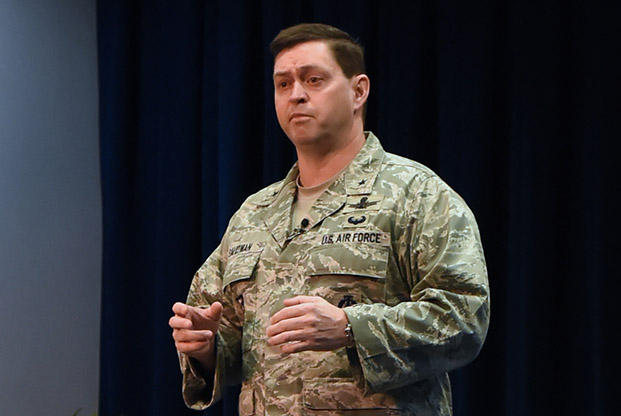
Brig. Gen. Chance Saltzman, director of current operations and head of the service’s multi-domain command and control initiative (shown here in California in 2017), called infrastructure key to successful multi-domain operations. Air Force photo by Sarah Corrice.
The inaugural Doolittle Wargame series, which will launch in November, will look at various types of command and control architectures to determine which ones would allow the service to use more information, better leverage support, and to make decisions faster in a multi-domain environment.
Infrastructure is the key to successful multi-domain operations, and making sure the Air Force has the right architecture in place is a “stellar” undertaking, Brig. Gen. Chance Saltzman, director of current operations and head of the service’s multi-domain command and control initiative, said during an AFA Mitchell Institute event on Wednesday.
To illustrate his point, Saltzman showed a picture of the Motorola DynaTAC 8000X, the world’s first cell phone—a massive and clunky (according to today’s standards) piece of technology that sold for just under $4,000 in 1984. And to its right, he showed a picture of a newer model iPhone displaying a variety of different apps.
He joked that his children today don’t even use the iPhone to make telephone calls, but if the same piece of technology had been created in 1985, “it would be just as effective as the phone on the left. You could make phone calls with it,” because the Internet was not yet available to the general public and data lines did not exist to enable text messaging.
“Once we get the infrastructure right, I’m convinced that the applications will be much faster in development and integration,” said Saltzman, though he acknowledged that requires a significant culture shift inside the Air Force. Everything from how the service works with Congress, industry, and academia, to the way it conducts operations will have to change, and all of those things must happen in parallel to one another, he added.
The Air Force needs to give industry and academia the “basic principles and basic vision” for how it wants to conduct multi-domain operations, and then let them work independently to find the right way to make that happen. Then the service needs to figure out how “to pull them back in” when it’s “ready to start procurement, and contract work, and some of those mechanics,” said Saltzman.
“There’s a struggle here. This is that cultural shift,” he said. “If we’re sitting around waiting for that master conops, the master list of requirements that define MDC2, I’m telling you it’s not coming. It’s not coming because I don’t think that’s the best way to structure all the disparate efforts that have to happen. I would much rather focus on standards for the basic foundational work so everybody who is working on the different disparate aspects knows how their project will fit in. Then we have to figure out what the right contracting mechanisms are, what the right lab work is, how you go from experiments and technology demonstrations to operationalizing this. What does program of record mean in this environment?”
All those questions are being asked, he said, at the most senior levels of the Air Force. For now, he said, “The short answer is we don’t want to control too much. We want to have the grand vision so everybody can contribute the way they see works best,” while the Air Force figures out “a new path” for bringing on new “capability effectively and fast,” said Saltzman.

